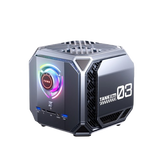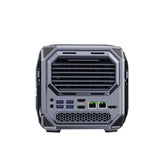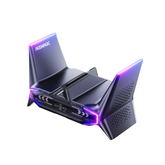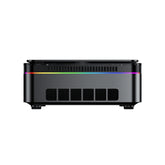Intel Celeron Processor vs Pentium: Key Differences and Best Use Cases

Choosing the right processor is essential for optimizing your computer’s performance and ensuring it meets your specific needs. When comparing Celeron vs Pentium, understanding the differences between the Intel Celeron processor vs Pentium can help you make an informed decision. Both processors have been staples in Intel’s lineup, catering to different segments of the market.
The Intel Pentium processor vs Celeron debate often centers around performance, power efficiency, and price. While the Pentium series has historically been known for its higher performance and versatility in desktops and laptops, the Celeron line offers a more budget-friendly option suitable for basic tasks like web browsing and email. This blog will delve into the key distinctions between Intel Celeron vs Pentium processors, helping you determine which one aligns best with your computing requirements and budget.
Overview of Intel Celeron vs Pentium Processors
What is Intel Pentium?
Intel Pentium is a well-established processor line from Intel, recognized for its balance of performance and affordability. Launched in 1993, the Pentium series has undergone several iterations, evolving from the original P5 architecture to incorporate advancements from subsequent Intel microarchitectures.

The Pentium brand started as Intel’s flagship line, positioned above the Celeron series in terms of performance and features. Over the years, Pentium processors have transitioned through various architectures, including Pentium II, Pentium III, Pentium 4, and the more recent Pentium Silver and Gold variants. In 2006, with the introduction of the Intel Core series, Pentium shifted to a mid-range position, offering enhanced performance over Celeron while remaining more affordable than Core i3, i5, and i7 processors. This evolution reflects Intel’s strategy to cater to a broad spectrum of users, from everyday consumers to small businesses.
Key Features and Typical Specifications:
- Clock Speed: Pentium processors boast higher clock speeds compared to Celeron, often exceeding 3.0GHz in modern variants, which translates to better performance in multitasking and more demanding applications.
- Cache Memory: With larger cache sizes, typically ranging from 2MB to 4MB of L3 cache, Pentium CPUs handle data more efficiently, resulting in smoother performance during intensive tasks.
- Core Count: Pentium processors usually feature dual to quad-core configurations, providing robust multitasking capabilities suitable for a wider range of applications, including light gaming and multimedia editing.
- Integrated Graphics: Enhanced integrated graphics, such as Intel UHD Graphics, offer improved visual performance, supporting higher resolution displays and more graphic-intensive applications compared to Celeron.
- Advanced Technologies: Many Pentium models support technologies like Intel’s Hyper-Threading and Turbo Boost, which further enhance processing efficiency and speed, making them suitable for users who require more than basic computing power.
What is Intel Celeron?
Intel Celeron is Intel’s budget-friendly processor line, designed to deliver essential computing performance at an affordable price point. Introduced in 1998 as a spin-off of the Pentium II architecture, the Celeron series was created to cater to cost-sensitive consumers seeking reliable performance for everyday tasks without the premium features of higher-end processors.

The Celeron brand was launched to provide an economical alternative to Intel’s main processor lines, targeting entry-level desktops, low-cost laptops, and basic computing devices. Over the years, Celeron processors have evolved from being direct derivatives of Pentium architectures to incorporating elements from Intel’s Atom series, emphasizing energy efficiency and cost-effectiveness. This makes Celeron processors ideal for budget-conscious users, educational institutions, and small businesses requiring dependable performance for tasks like web browsing, document editing, and media playback.
Key Features and Typical Specifications:
- Clock Speed: Celeron processors typically feature lower clock speeds compared to their Pentium counterparts, balancing performance with energy consumption. Modern Celerons offer clock speeds ranging up to 2.4GHz.
- Cache Memory: They generally come with smaller cache sizes, often 128KB to 256KB of L2 cache, which suffices for basic computing needs but may limit performance in more demanding applications.
- Core Count: Most Celeron CPUs are dual-core, providing adequate multitasking capabilities for everyday use.
- Integrated Graphics: Equipped with Intel UHD Graphics, Celeron processors support essential graphic tasks, though they are not suited for intensive gaming or graphic design.
- Power Efficiency: Designed with energy efficiency in mind, Celeron processors are ideal for portable devices, offering longer battery life for laptops and reduced power consumption for desktops.
Key Differences Between Intel Celeron and Pentium CPUs
When choosing a processor for your computer, understanding the distinctions between Intel Celeron and Intel Pentium CPUs is essential. Although both processor lines are designed by Intel and cater to mainstream computing needs, they differ significantly in several key areas. Here are the five main differences between Intel Celeron and Pentium CPUs:
Celeron vs Pentium: Performance Levels
Intel Celeron Performance Levels
Designed as entry-level processors, Celeron CPUs offer adequate performance for basic computing tasks such as web browsing, email, and document editing. They are suitable for users with minimal processing demands and are commonly found in budget-friendly laptops and desktop systems.
Intel Pentium Performance Levels
Positioned above the Celeron line, Pentium processors deliver enhanced performance suitable for more demanding applications. They handle multitasking, light photo and video editing, and casual gaming more efficiently, making them ideal for users who require a balance between cost and performance.
Celeron vs Pentium: Clock Speeds and Core Counts
Typically features lower base and boost clock speeds compared to Pentium processors. While modern Celeron CPUs may have multiple cores (ranging from 2 to 4), their clock speeds are generally optimized for energy efficiency rather than high performance.
Offers higher clock speeds and, in some cases, more cores than Celeron processors. This results in better performance in both single-threaded and multi-threaded applications. Pentium CPUs are better equipped to handle tasks that require more processing power without compromising on speed.
Celeron vs Pentium: Cache Size
Generally comes with smaller cache sizes, often around 1.5 MB of L2 cache and up to 4 MB of L3 cache. Smaller caches can lead to increased latency and reduced efficiency in handling larger data sets or more complex applications.
Equipped with larger cache sizes, typically ranging from 4 MB to 8 MB of Intel Smart Cache. A larger cache allows for quicker data access and better performance in tasks that involve frequent data retrieval and processing, enhancing the overall responsiveness of the system.
Celeron vs Pentium: Performance Levels
Typically lacks some of the advanced features found in Pentium processors. Features such as Intel Hyper-Threading, Turbo Boost™, and higher memory support are often disabled or unavailable in Celeron CPUs. This limitation affects their ability to perform complex and resource-intensive tasks efficiently.
Pentium: Includes more advanced technologies and features, enhancing their performance and versatility. Intel Pentium processors often support Hyper-Threading, Turbo Boost™, and higher memory bandwidth, enabling better performance in multitasking, media editing, and other demanding applications.
Celeron vs Pentium: Performance Levels
Celeron: Positioned as a cost-effective solution, Celeron processors are priced lower than Pentium CPUs. They are targeted towards budget-conscious consumers and are ideal for basic computing needs without the requirement for high performance.
Pentium: Priced higher than Celeron processors, Pentium CPUs offer a better performance-to-cost ratio for users who need more processing power without moving to the higher-priced Core series. Pentium processors provide added value through enhanced performance and additional features, making them a popular choice for mainstream users seeking reliable and efficient computing.
Is Celeron CPU Always Weaker Than Pentium CPU?
Overall, Intel Celeron processors are positioned in the entry-level market, suitable for basic computing tasks such as web browsing, email, and document editing. In contrast, Intel Pentium processors typically perform better in aspects like clock speed, number of cores, and cache size, enabling more efficient handling of multitasking, lightweight photo and video editing, as well as casual gaming and other relatively more complex applications.
However, Celeron processors are not necessarily weaker than Pentium processors. CPU speed and Thermal Design Power (TDP) are key factors for performance differences. For example, the Celeron J425 CPU is better than the Pentium Silver N5000 CPU, but the Pentium J5040 CPU outperforms the Celeron J4125 CPU. In certain specific tasks or scenarios, Celeron processors can match or even outperform Pentium processors in particular applications. Additionally, Celeron processors are more affordable, making them suitable for users with limited budgets and lower performance requirements, such as basic office and entertainment needs.
Recommended Reading: Pentium Silver N5000 vs Celeron J4125
How to Choose Between Celeron and Pentium Processors
While Intel Celeron processors are typically less powerful than Intel Pentium processors, they are not inherently "weaker" in every context. Celeron CPUs are perfectly adequate for basic, everyday tasks and offer excellent value for budget-conscious consumers. Pentium processors, on the other hand, provide enhanced performance and features that make them better suited for users with more demanding computing needs.
Choosing between a Celeron and a Pentium processor should be based on your specific usage requirements and budget. If you need a processor for simple tasks and want to minimize costs, a Celeron is a solid choice. If you require better performance for multitasking, light creative work, or casual gaming, investing in a Pentium processor will offer a more satisfying and efficient computing experience.
Intel Celeron N5095 and Pentium Silver N6000

To help you decide between the Intel Celeron N5095 and Intel Pentium Silver N6000 processors, here's a concise comparison table highlighting their key similarities and differences:
| Feature | Intel Celeron N5095 | Intel Pentium Silver N6000 |
|---|---|---|
| Architecture | Jasper Lake (Tremont) | Jasper Lake (Tremont) |
| Launch Date | Early 2021 | Early 2021 |
| Cores/Threads | 4 Cores / 4 Threads | 4 Cores / 4 Threads |
| Base Clock Speed | 2.0 GHz | 1.1 GHz |
| Turbo Boost Speed | Up to 2.9 GHz | Up to 3.3 GHz |
| Cache | 1.5 MB L2 + 4 MB L3 | 1.5 MB L2 + 4 MB L3 |
| Manufacturing Process | 10 nm Tremont | 10 nm Tremont |
| TDP (Thermal Design Power) | 15 W | 6 W |
| Integrated Graphics | Intel UHD Graphics (16 EU, up to 750 MHz) | Intel UHD Graphics (32 EU, up to 850 MHz) |
|
Memory Support
|
Dual-channel DDR4/LPDDR4x up to 16 GB @ 2933 MHz | Dual-channel DDR4/LPDDR4x up to 16 GB @ 2933 MHz |
|
Video Support
|
True 4K (4096×2160) @ 60 Hz | True 4K (4096×2160) @ 60 Hz |
|
Additional Features
|
|
|
|
Form Factor Compatibility
|
Designed for affordable SFF desktops and laptops | Primarily intended for inexpensive notebooks and mini PCs |
|
Power Consumption
|
Higher power consumption requires better cooling | Low power consumption ideal for passively cooled devices |
|
Performance Profile
|
|
|
Similarities Between Celeron N5095 and Pentiu N6000
Both the Intel Celeron N5095 and Pentium Silver N6000 are built on Intel’s Jasper Lake architecture, which is designed to deliver efficient performance for everyday computing tasks while maintaining low power consumption. They feature a quad-core configuration with four threads, enabling smooth multitasking for basic activities like web browsing, email, and document editing.
Additionally, both processors come equipped with 1.5 MB of L2 cache and 4 MB of L3 cache, enhancing data processing speeds and overall system responsiveness. Integrated Intel UHD Graphics allow both CPUs to handle basic graphical tasks such as video playback, light photo editing, and casual gaming without the need for a dedicated graphics card. Furthermore, they support dual-channel DDR4 or LPDDR4x memory configurations up to 16 GB at 2933 MHz, ensuring efficient memory access and improved system performance. Both processors are ideal for compact systems like budget-friendly laptops, desktops, and mini PCs, offering reliable performance for everyday use.
Differences Between Celeron N5095 and Pentium N6000
Despite their similarities, the Intel Celeron N5095 and Pentium Silver N6000 have distinct differences that cater to different user needs. The Celeron N5095 operates at a higher base clock speed of 2.0 GHz and can boost up to 2.9 GHz, making it better suited for multi-core tasks and sustained performance. In contrast, the Pentium Silver N6000 has a lower base clock of 1.1 GHz but can turbo boost up to 3.3 GHz, enhancing its performance in single-threaded applications such as web browsing and light productivity tasks.
Another key difference is their Thermal Design Power (TDP). The Celeron N5095 has a TDP of 10 Watts, balancing performance and energy consumption, which makes it suitable for budget systems that require moderate power usage. On the other hand, the Pentium Silver N6000 boasts a lower TDP of 6 Watts, making it more energy-efficient and ideal for ultra-portable devices where battery life and minimal heat generation are priorities.
In real-world applications, the Pentium Silver N6000 tends to excel in single-core performance due to its higher turbo boost frequency, while the Celeron N5095 performs better in multi-core scenarios thanks to its higher base clock speed. This makes the Celeron N5095 a better choice for users who frequently multitask or run applications that benefit from multiple cores, such as light media editing or managing several browser tabs simultaneously. Conversely, the Pentium Silver N6000 is more suited for users who prioritize energy efficiency and require a processor that can handle single-threaded tasks efficiently, making it perfect for ultra-portable laptops and compact desktops.
Recommended Reading: Intel Pentium Silver N6000 vs Intel Celeron N5095
Celeron N5095 vs Pentium Gold G6605

Choosing the right processor is crucial for optimizing your computer's performance based on your specific needs and budget. Below is a comparison table highlighting the key specifications of the Intel Celeron N5095 and Intel Pentium Gold G6605 processors, followed by a concise summary of their similarities and differences.
| Feature | Intel Celeron N5095 | Intel Pentium Gold G6605 |
|---|---|---|
| Architecture | Jasper Lake (Tremont) | Jasper Lake (Tremont) |
| Launch Date | Early 2021 | Q1 2021 |
| Cores/Threads | 4 Cores / 4 Threads | 2 Cores / 2 Threads |
| Base Clock Speed | 2.0 GHz | 4.3 GHz |
| Max Turbo Frequency | Up to 2.9 GHz | 4.3 GHz |
| Cache | 1.5 MB L2 + 4 MB L3 | 4 MB Intel Smart Cache |
| TDP (Thermal Design Power) | 15 W | 58 W |
| Integrated Graphics | Intel UHD Graphics (16 EU, up to 750 MHz) | Intel UHD Graphics 630 |
| Memory Support | Dual-channel DDR4/LPDDR4x up to 16 GB @ 2933 MHz | Dual-channel DDR4/LPDDR4x up to 16 GB @ 2933 MHz |
| Video Support | True 4K (4096×2160) @ 60 Hz | True 4K (4096×2160) @ 60 Hz |
| Additional Features |
|
|
| Form Factor Compatibility | Affordable SFF desktops and laptops | Inexpensive notebooks and mini PCs |
| Power Consumption | Higher power consumption requires better cooling | Higher performance with greater power demand |
| Performance Profile | Better multi-core performance | Superior single-core performance |
Similarities Between Intel Celeron N5095 and Pentium Gold G6605
Both the Intel Celeron N5095 and Pentium Gold G6605 are built on Intel’s Jasper Lake (Tremont) architecture, designed to provide efficient performance for everyday computing tasks while maintaining energy efficiency. They support dual-channel DDR4 or LPDDR4x memory configurations up to 16 GB at 2933 MHz, ensuring smooth and responsive system performance. Additionally, both processors are capable of outputting true 4K video at 60 Hz, delivering high-definition media playback without the need for a dedicated graphics card.
These CPUs are integrated with Intel UHD Graphics, enabling them to handle basic graphical tasks such as video playback, light photo editing, and casual gaming. Their compact design makes them ideal for use in budget-friendly laptops, desktops, and mini PCs, providing reliable performance for standard computing needs without excessive power consumption or heat generation.
Differences Between Intel Celeron N5095 and Pentium Gold G6605
The primary distinction between the Intel Celeron N5095 and Pentium Gold G6605 lies in their performance capabilities and power consumption. The Celeron N5095 features a quad-core configuration with four threads, operating at a base clock speed of 2.0 GHz and boosting up to 2.9 GHz. This makes it well-suited for multi-core tasks and multitasking environments, where handling multiple applications simultaneously is essential. However, its higher Thermal Design Power (TDP) of 15 W demands more robust cooling solutions to maintain optimal performance.
In contrast, the Pentium Gold G6605 is a dual-core processor with two threads, boasting a significantly higher base clock speed of 4.3 GHz. This allows for superior single-core performance, making it ideal for tasks that rely heavily on single-threaded applications such as gaming and productivity software. The Pentium Gold G6605 has a higher TDP of 58 W, reflecting its enhanced performance capabilities but also resulting in greater power consumption and heat output compared to the Celeron N5095.
Furthermore, the Pentium Gold G6605 is equipped with a more powerful Intel UHD Graphics 630 GPU, offering better performance for graphical tasks and light gaming compared to the Celeron N5095’s Intel UHD Graphics (16 EU). This makes the Pentium Gold G6605 a better choice for users who require higher graphical performance alongside robust processing power.
Recommended Reading: Intel Celeron N5095 vs Pentium Gold G6605
Conclusion
Intel Celeron processors are ideal for entry-level tasks like web browsing and document editing, offering affordability with lower clock speeds and fewer cores. In contrast, Intel Pentium processors provide better performance for multitasking, light photo/video editing, and casual gaming, thanks to higher clock speeds and more cores. However, certain Celeron models can match or exceed specific Pentium models in particular scenarios.
Choose a Celeron processor if you have basic computing needs and a limited budget. Opt for a Pentium processor if you require enhanced performance for more demanding tasks and are willing to invest a bit more. Always compare specific models to ensure the best fit for your performance requirements and budget.
Read More:
Amd Ryzen 5 vs Intel i5: Differences & How to Choose
Intel vs AMD Ryzen Mini PC: The Best and Real Comparison







Leave a comment
Please note, comments need to be approved before they are published.